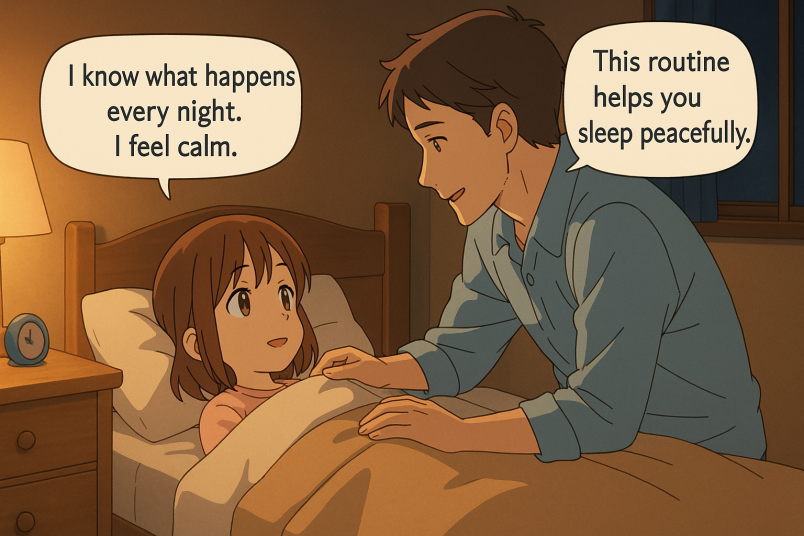9 Signs of Secure Attachment in Children & How to Develop

Unlock Daily 30-Sec Tips for a Happier Relationship
👉 Subscribe FREEKey Takeaways
Marriage.com AI Quick Summary
Have you ever noticed the way a child lights up when their caregiver walks into the room?
Or how they reach out instinctively for comfort when they are scared?
These little moments might seem ordinary, but they carry so much meaning. A secure attachment is built in the quiet rhythms of daily life—through cuddles, shared laughter, patient listening, and even the tears that are soothed away.
It is not about being perfect, but about being present; not about never leaving, but about always returning.
When children feel loved, safe, and understood, they begin to trust both themselves and the world around them… and that trust shapes how they grow, explore, and connect with others in beautiful ways!
What is secure attachment theory?
Secure attachment theory, rooted in the work of psychologist John Bowlby and further developed by Mary Ainsworth, posits that the bonds formed between children and their caregivers in the early years of life have profound and lasting impacts on their emotional development and interpersonal relationships.
According to this theory, a secure attachment develops when caregivers consistently meet the child’s comfort, care, and security needs, encouraging trust and safety. Children who develop this style are more likely to exhibit resilience, emotional regulation, and positive social interactions.
9 signs of secure attachment in children
Identifying signs of secure attachment in children is pivotal for understanding their emotional health and the strength of their bond with caregivers.
Secure attachment signals that a child feels safe, loved, and supported, laying the groundwork for healthy emotional development. Here are 9 signs indicative of a securely attached child:
1. Seeking comfort from caregivers
When a child feels upset or frightened, they naturally turn to their caregivers for comfort and reassurance. This behavior indicates trust and confidence in the caregiver’s ability to provide safety and emotional support, essential components of a secure attachment.
According to Grady Shumway, LMHC:
Consistently responding with warmth and reliability reinforces this sense of security, helping the child develop healthy emotional regulation and stronger relationships in the future.
- Positive things you might notice: You may see your child calming down more quickly after being comforted, showing relief when held, or even expressing gratitude in their own small ways. This responsiveness reinforces your bond and builds their emotional confidence.
2. Showing distress upon separation
It’s normal for securely attached children to show signs of distress when separated from their primary caregivers. This reaction underscores their strong bond and preference for their caregivers, reflecting a healthy attachment.
- Positive things you might notice: Even if separation distress feels challenging, it is a positive sign that your child values your presence deeply. After the reunion, they may express happiness, cling briefly, and then return to play with greater confidence.
A study examined caregiver preferences of toddlers under distress and contentment. Results showed that, regardless of attachment security, distressed toddlers sought their primary caregiver, while no preference appeared when content. Recovery from distress was linked to attachment security with the caregiver they approached.
3. Greeting caregivers positively
Securely attached children often display positive emotions, such as joy and excitement, upon reuniting with their caregivers. This warm greeting is a testament to the child’s strong affection and bond with their caregiver.
- Positive things you might notice: Look for smiles, laughter, or eager hugs when you come back. These gestures reveal that your child not only missed you but also associates your presence with comfort, love, and happiness.
4. Using caregivers as a secure base
A securely attached child feels comfortable exploring their environment, knowing they can return to their caregiver for support and comfort. This balance of exploration and connection illustrates the child’s trust in the caregiver’s availability and responsiveness.
- Positive things you might notice: You may see your child venture out to explore toys, friends, or new places, but frequently glance back or return for reassurance. This shows healthy independence rooted in strong trust.
5. Trusting caregivers
These children exhibit a deep trust in their caregivers to meet their needs, both emotionally and physically. This trust is foundational to secure attachment, enabling the child to feel safe and secure in their relationship.
- Positive things you might notice: Your child may openly express needs, share feelings, or confidently ask for help without hesitation. This openness reflects trust and helps them build healthy ways of communicating with others.
6. Showing emotional regulation
Securely attached children generally manage their emotions better, demonstrating resilience in stressful situations. This emotional regulation is encouraged by the consistent support and understanding they receive from their caregivers.
- Positive things you might notice: You may notice your child calming themselves after small frustrations, bouncing back after disappointments, or expressing feelings without prolonged distress. This balance signals they feel safe enough to process emotions.
7. Displaying empathy
A sign of secure attachment is the development of empathy toward others. These children can understand and share the feelings of others, a skill nurtured through the empathetic care they receive from their caregivers.
- Positive things you might notice: Your child might comfort a sad friend, share toys willingly, or show concern when someone gets hurt. These small acts reflect the empathy they’ve internalized through secure, caring interactions.
8. Engaging in cooperative play
Children with secure attachments often engage in positive, cooperative play with peers. This social skill reflects the child’s ability to form healthy relationships, influenced by the secure bond with their caregivers.
- Positive things you might notice: You may see your child taking turns, negotiating fairly, or including others in games. These cooperative skills are signs that they trust relationships and feel confident in social situations.
9. Adapting to new situations
Securely attached children adapt more readily to new situations and challenges. Their resilience is a direct result of the secure base provided by their caregivers, allowing them to approach new experiences confidently.
- Positive things you might notice: Your child may show curiosity in new environments, adjust well to meeting new people, or display enthusiasm for unfamiliar activities. This flexibility signals security in themselves and faith in your support.
What are the four attachment styles?
Understanding the four attachment styles is essential for grasping how children and adults relate to others in their relationships.
These styles, developed early in life, influence a wide range of behaviors, from anxious to secure attachment, affecting how individuals manage emotions, intimacy, and conflict. Here’s a closer look at each of these 4 types of attachment styles:
1. Secure attachment
Individuals with a secure attachment style feel comfortable with intimacy and are usually warm and loving in their relationships.
They can rely on others and be relied upon, maintaining a healthy balance between independence and connectedness. This style forms the foundation for stable and positive relationships, where communication is open and both parties feel valued and understood.
2. Anxious-preoccupied attachment
An anxious-preoccupied attachment is characterized by a strong desire for closeness paired with persistent worry about the relationship’s stability. People with this attachment often seek approval and reassurance from their partners, fearing abandonment.
Research shows that individuals with anxious attachment tend to hold positive beliefs about others, along with experiencing low self-esteem and fear of abandonment. As a result, they may rely more heavily on seeking reassurance from others in order to feel secure in their relationships and establish their self-worth.
Their heightened sensitivity to perceived threats to the relationship can lead to clinginess and a roller-coaster of emotional highs and lows, reflecting an anxious-to-secure attachment dynamic.
3. Dismissive-avoidant attachment
Individuals who exhibit a dismissive-avoidant attachment style tend to maintain emotional distance from others.
They prioritize independence and self-sufficiency over forming close emotional bonds and often dismiss the importance of relationships. This avoidant secure attachment approach can result in difficulties with intimacy and a reluctance to rely on others or open up emotionally.
Grady Shumway highlights that:
While this attachment style may provide a sense of control, it can lead to loneliness and difficulty forming deep connections. Developing self-awareness and gradually building trust in relationships can help create a healthier balance between independence and emotional closeness.
4. Fearful-avoidant attachment (Disorganized)
Such a style is marked by conflicting feelings about close relationships: a desire for emotional closeness mixed with a fear of vulnerability.
Individuals with fearful-avoidant attachment often experience high levels of anxiety in relationships and may exhibit unpredictable or erratic behavior. Their fear of being hurt or abandoned clashes with their longing for intimacy, which can lead to a complex and challenging attachment dynamic.
7 ways to develop a secure attachment with your child
Promoting a secure attachment with your child is a critical aspect of parenting that supports their emotional and social development. Securely attached children are more likely to become resilient, empathetic, and emotionally healthy adults.
Here are 7 ways to develop a secure attachment and how you can put them into practice:
1. Be consistently responsive
Respond to your child’s needs in a timely and predictable manner. Whether they are hungry, tired, frightened, or just need a hug, showing that you are reliably there for them builds trust and security.
A few examples of secure attachment include comforting your child when upset and celebrating their achievements, big or small.
Here’s what you can do:
- Pay attention to your child’s cues, like changes in tone or body language, and respond quickly.
- Make small daily rituals (like bedtime check-ins) to show reliability.
- Offer comfort during both big and small moments, reinforcing that you are there no matter what.
2. Provide physical affection
Regular hugs, kisses, and cuddles are simple yet powerful ways to strengthen your bond. Physical affection reassures your child of your love and presence, creating a warm and loving environment that supports secure attachment.
Here’s what you can do:
- Hug your child every morning and night to create consistent moments of closeness.
- Hold their hand during walks or when they feel unsure in new environments.
- Use physical touch like high-fives or pats on the back to celebrate their efforts.
3. Practice active listening
Listen to your child with full attention, validating their feelings and experiences. This shows them that their thoughts and emotions are important and that they can trust you with their inner world.
Active listening promotes open communication and mutual respect, which are pillars of a secure attachment.
Here’s what you can do:
- Put away distractions (like phones) when your child is talking to you.
- Reflect back what they say in simple words to show you understand.
- Validate their feelings, even if you do not agree, by saying things like, “I can see that made you upset.”
4. Spend quality time together
Dedicate time to just being with your child and engaging in activities they enjoy. Whether it’s playing games, reading stories, or exploring nature, quality time is crucial for building a strong, secure relationship.
These shared moments create lasting memories that children carry into adulthood. Even small, everyday interactions can deepen trust and strengthen your bond over time.
Here’s what you can do:
- Set aside at least 15–20 minutes daily for uninterrupted time together.
- Let your child choose the activity so they feel their preferences matter.
- Use everyday routines (meals, rides, bedtime) as bonding opportunities by engaging in conversation.
5. Encourage independence
While it may seem counterintuitive, promoting independence is a key aspect of developing secure attachment.
Support your child’s efforts to explore and learn on their own, providing a safe and secure base for them to return to. This balance of independence and security encourages confidence and resilience.
Here’s what you can do:
- Allow your child to try age-appropriate tasks independently, like dressing themselves.
- Encourage exploration, but reassure them you are nearby if needed.
- Celebrate their efforts rather than just outcomes, building confidence in the process.
Watch this TED Talk where Julie Lythcott-Haims, the former Dean of Freshmen at Stanford, explains how to raise successful kids without over-parenting:
6. Set and enforce boundaries
Consistent and fair boundaries make the world feel more predictable and safe for children. By setting clear expectations and following through with consequences in a loving way, you teach your child self-discipline and help them understand the importance of rules and limits.
Here’s what you can do:
- Clearly explain rules and the reasons behind them in simple terms.
- Stay calm and consistent when enforcing boundaries, avoiding mixed signals.
- Use natural consequences (like cleaning up spilled toys) instead of harsh punishments.
7. Seek out social support
Building a secure attachment doesn’t mean you have to do it all alone. Engage with a supportive community of family, friends, and professionals.
Sharing experiences and receiving encouragement can provide you with new perspectives and strategies, enriching the way you relate to your child.
Here’s what you can do:
- Clearly explain rules and the reasons behind them in simple terms.
- Stay calm and consistent when enforcing boundaries, avoiding mixed signals.
- Use natural consequences (like cleaning up spilled toys) instead of harsh punishments.
FAQs
Building a secure attachment with your child can prompt a range of questions and concerns. We’ve compiled a list of frequently asked questions to help clarify this vital aspect of child development.
-
What are some common misconceptions about secure attachment?
A common misconception is that secure attachment means a child will never show independence or discomfort.
In reality, securely attached children confidently explore their environment and express a range of emotions, knowing they have a safe base to return to. Another myth is that attachment is solely formed in infancy, ignoring the ongoing development through childhood.
-
What should I do if I am concerned about my child’s attachment style?
If you’re concerned about your child’s attachment style, consider seeking advice from a pediatrician or a child psychologist.
They can offer insights into your child’s behaviors and recommend strategies or interventions. Early engagement with professionals can address and support the development of a more secure attachment style.
-
What resources are available to help me create a secure attachment bond with my child?
Numerous resources can support building a secure attachment, including parenting books, workshops, and online courses focusing on responsive caregiving and emotional communication. Websites of reputable child development organizations often provide free articles, videos, and tips on promoting secure attachments through everyday interactions.
-
Are there any programs or interventions that can help strengthen attachment?
Various programs and interventions are designed to strengthen the parent-child attachment relationship. These may include therapy sessions focused on enhancing emotional communication, parenting classes that teach responsive caregiving techniques, and community support groups where parents can share experiences and strategies.
Consulting with a child development specialist can help identify the most suitable program for your family’s needs.
Growing bonds that last
Secure attachment is not about grand gestures, but about the small, steady ways love shows up each day. A reassuring hug, a patient ear, a smile that says “I see you”… these are the moments that shape a child’s sense of safety and belonging.
It may not always feel easy, and of course, no caregiver gets it right every time! But what matters most is being there, showing consistency, and creating a space where children feel understood. Over time, those everyday acts build trust, resilience, and lifelong connection.
 Tips
Tips
Write your tip or submit a video tip
All tips are reviewed before the publishing.
Share this article on
Want to have a happier, healthier marriage?
If you feel disconnected or frustrated about the state of your marriage but want to avoid separation and/or divorce, the marriage.com course meant for married couples is an excellent resource to help you overcome the most challenging aspects of being married.
Recent Articles
Related Quizzes
Unlock Daily 30-Sec Tips for a Happier, Healthier Relationship
👉 Subscribe FREE on YouTube We'd love your feedback!
We'd love your feedback!
 Expert Q&A
Expert Q&A
Ask your question related to this topic & get the support you deserve from experts.





















 Thanks for your feedback!
Thanks for your feedback!